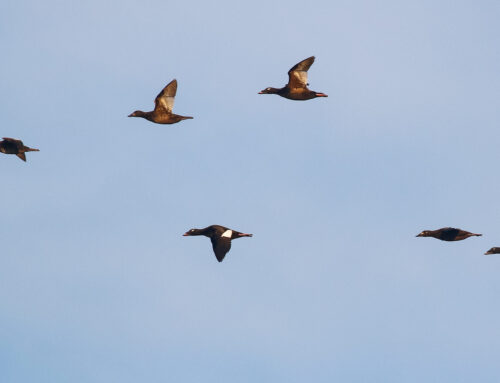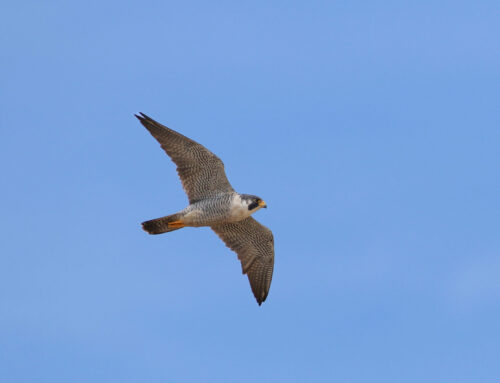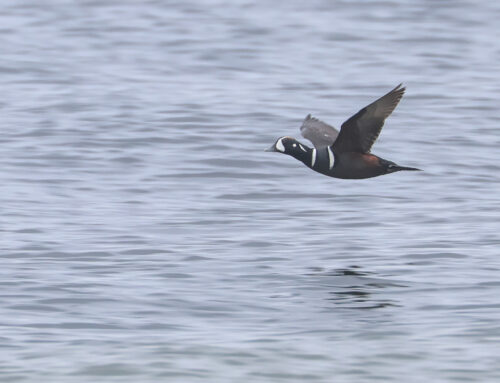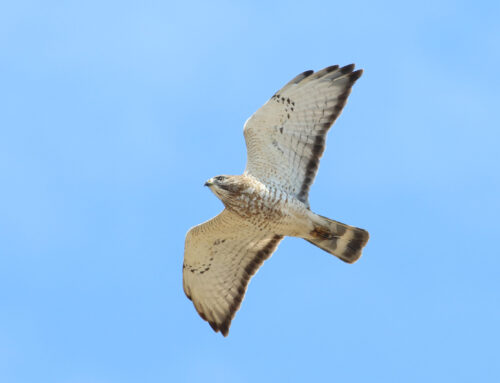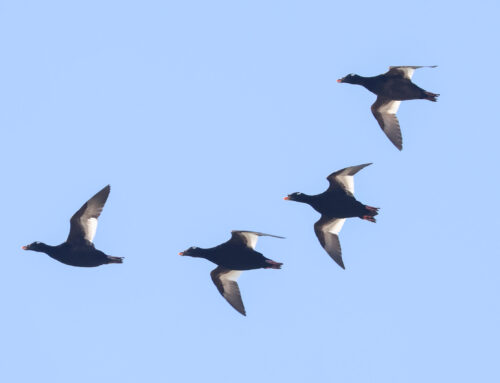The month of May began with soggy, wet conditions, and the days that followed (May 2 and 3) did not fare much better. Northwest winds funneled in off the lake, keeping much of the raptor movement at bay. Conditions improved dramatically by May 4, and BROAD-WINGED HAWK kettles began forming by the late morning hours. Similar to the first large push on April 30, kettles remained very distant to the southwest and spiraled for hours on the horizon line. While challenging to quantify in a standardized count, there is some humor in watching the erratic groups of birds darting back and forth along the Point, seemingly unsure of where to go, whether to cross the open water with Canada in sight or to turn back to the south and find new passage north. However, the broad-wings seem to do this with such a level of patience while aloft that there is little rush on their arrival at their northern breeding grounds, spiraling endlessly in the late-day thermals. Eventually, the broad-wings would continue south — likely following the contours of the shoreline until continuing onward. A total of 830 BROAD-WINGED HAWKS and 12 different migrant raptor species would be tallied by the end of the count that day.

Adult Broad-winged Hawk passing over the hawk deck in the late afternoon on May 7. Photo by Jess Cosentino
With more sporadic rain in the forecast, May 5 saw a return to less favorable conditions with SHARP-SHINNED HAWKS predominantly on the move. While the count’s species diversity may remain on the lower side these days, triple-digit sharpie counts provide evidence that the spring raptor migration still has a pulse. As the day progressed, a wall of rain slowly moved up from the south and landed on the Point by the late afternoon, which shut down the remainder of any raptor flight for the day. One notable upside of successive poor weather condition days is that it seems to back up migrant raptors to the south as they wait for a window of good conditions, often associated with wind direction.
This window of opportunity may only be a few hours, as was the case on the following days: May 6 and 7. I woke up shortly after sunrise on Saturday to the sharp pitter-patter of cold rain on the aluminum roof. Swinging my legs off the bed, I peered out the window to the north and quietly mumbled, “Well…no count today”. Shuffling to the kitchen to start the first pot of coffee, I spent the next few hours idly refreshing the weather radar map. There is always a hesitancy with calling off a raptor count for the day; if you do it too early, there is a chance that the poor weather could break and migrants begin moving again. By noon, the green blob on the radar had just cleared to the north of the Point, and a quick glance out the window showed a decreasingly grayish sky with hints of sun. I grabbed the scope and headed up to the dunes with a small reservoir of optimism for the remainder of the day…but I did regret not bringing more coffee along with me.
Within the first hour, I could sense that migrant birds were taking advantage of the southeast winds after the wall of morning rain had cleared to the north: Beginning with a pair of adult PEREGRINE FALCONS coasting down the shoreline within the first minutes of resuming the count, to flocks of hundreds of PURPLE FINCHES, to a single pair of AMERICAN PIPITS calling overhead, and small groups of YELLOW-RUMPED WARBLERS flitting past the deck. Around 180 SHARP-SHINNED HAWKS in the first couple hours felt like some good momentum, but my optimism did not see it lasting too deep into the afternoon hours; however, I was glad to be tallying at least some migrants today, given the wet morning! Little did I know then that over the next four hours, the stream of sharpies flooding in from the south over the dunes would not relent — 200, 331, 311, and 217 hourly count totals, respectively. At one point around 5 p.m., I stared off into the southwest horizon and could easily count another 60 on their way north with no immediate end to the push of migrants in sight. While standing on the hawk deck, I could slowly spin in a 360-degree circle while surrounded by sharpies visible with the naked eye, in all directions, at varying heights and distances. The sun continued to slowly set with the nearby spring peepers beginning their crepuscular chorus, and by the end of the count, just two hours before sunset, 1,306 migrant SHARP-SHINNED HAWKS would be tallied from the hawk deck — so far, the season’s high count for a single day.
While this incredible accipiter flight would have been a tremendous stand-alone treat given the late start due to rain, the best NORTHERN HARRIER flight (30) so far this season would pass as well with the long-winged raptors delicately flying their way along the shorelines well into the hours leading up to sunset, as well as the best PEREGRINE FALCON flight (9) on the season and several OSPREY (7). Several birds appeared to the southwest and pushed low over the dunes as the assisting southeast winds funneled in late-day migrants.

Northern Harrier over the dunes — one of 30 migrant harriers tallied throughout the afternoon hours on May 6. Photo by Jess Cosentino
Today (May 7) was a repeat of poor morning conditions with moderate-to-heavy rainfall throughout the count hours until early afternoon. However, as mentioned above, it’s difficult to officially call off the raptor count while there is still daylight, and today was no exception. The final raindrops seemed to taper by 3 p.m. I quickly drove up to the dunes around 4 p.m., only to be met with a flurry of SHARP-SHINNED HAWKS spilling by at treetop level. I quickly ran back home to get a few things and returned to the hawk deck with clicker in hand. Over the next two hours, 237 sharpies would be tallied along with a nice kettle of 110 BROAD-WINGED HAWKS to the distant southwest. It’s incredible how birds can and do respond to dynamic, changing weather patterns during migration to fully take advantage of good conditions.
May has been off to a blended start with a mix of good migrant pushes coupled with inclement, wet weather that has shut down much of a flight at times. However, some great days lie ahead. This week brings more southerly winds and, with any luck, accompanying migrant raptors with them.
~ Jess Cosentino
Spring Raptor Counter
Featured Photo: View from the hawk deck looking southwest at 5:30 p.m. on May 6, while a flurry of hundreds of Sharp-shinned Hawks continues to migrate north over the dune into the final hours of daylight. Can you spot the sharpie flying overhead? Photo by Jess Cosentino

